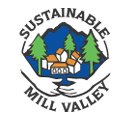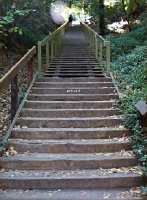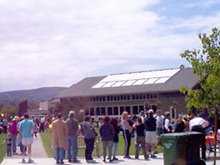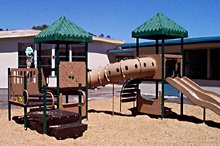

 |
 |
Current Projects Mill Valley City Council Candidates Survey SMV has submitted a survey to the candidates running for election to the Mill Valley City Council, with the goal of bringing to light their accomplishments and perspectives on sustainability issues of concern to the community. Click below to view the survey, and the answers the candidates provided: Click here to read the survey Click on a candidates' name to read their reply to the entire survey (listed in order of responses received): The above listed candidates provided their responses on or before the date we requested them to do so. Candidates below entered their answers after the deadline and may have had the benefit from reading already submitted answers. Other candidates' replies will be added upon receipt. Click on the individual issue to read all candidates' replies to that issue:
 Past Projects Marin Supervisor Election Survey SMV has submitted a survey to the candidates running for Marin County Supervisor with the goal to bring to light their accomplishments and perspectives on sustainability issues of concern to the community. Click below to view the survey, and the answers the candidates provided. Note that out of the original field of five candidates, we are only listing the responses of the two remaining candidates who will face each other in the November runoff election: Click here to read the survey (html) (pdf) Click on a candidates' name to read his reply to the entire survey: Click on the individual issue to read all candidates' replies to that issue:
 Climate Protection Resolution SMV is now primarily focused on promoting the City of Mill Valley's adoption of the CCP Resolution.
 A Sustainable Mill Valley Takes Shape "What is sustainability? How does sustainability relate to our life here in Mill Valley?" Sustainability goes beyond environmentalism and the protection and conservation of our natural environment. It is the measure of human impact on our world and the ability of our planet's natural systems to continue to support 10 billion people and all other life forms by the year 2050. To learn how our human lifestyles impact the earth's ability to continue to sustain all life, and how we can begin to make appropriate changes to become sustainable, see A Tutorial: A Sustainable Mill Valley Takes Shape. Mill Valley: Moving Toward Sustainability Members of Sustainable Mill Valley met with the Mill Valley City Council on October 7, 2002, to review the outcomes of the July seminar and to highlight for Council our recommendations for high priority sustainability initiatives the City could take to move us in the direction of a Sustainable Mill Valley. Our two recommended initiatives follow. MILL VALLEY: MOVING TOWARD SUSTAINABILITY Sustainability Seminar held in City Council Chambers July 25, 2002 Sustainability Visions and Ideas for Mill Valley Proposed by Charles McGlashan (presenter) and Seminar Participants Sustainable Transportation
Proposed Sustainability Initiatives for Mill Valley Proposed by Sustainable Mill Valley (SMV) to Mill Valley City Council October 7, 2002 Energy Efficiency Standards Ordinance (aka: Big & Tall Ordinance)
Community Lecture In June 2000, Sustainable Mill Valley participated in Whole Food's Community Lecture series. We produced a free panel discussion, Sustainability 101. Our panel included representatives from Muir Woods, Redefining Progress (Ecological Footprint), Sustainable North Bay, and a psychologist who is an expert in social transformation and its relationship to sustainability. Five of our current core membership joined us after attending this event. Mill Valley Memorial Day Parade SMV marched in this year's Memorial Day parade. Our float was an electric GEM car decorated with all-recycled materials. Marin Countywide Plan The Marin County Board of Supervisors elected to have sustainability be the context for the countywide plan update. SMV has participated in all six of the public workshops throughout the county and has publicized the events and reported on the outcomes. The City of Mill Valley hosted the workshop on February 10, 2001, led by Southern Marin Supervisor Annette Rose. SMV members facilitated the production of the event. Educational Art Performance SMV presented The Building Blocks of Sustainability, an educational art performance for Mill Valley's Centennial Celebration in September 2000, attended by over 2000 residents. This performance, available for other educational and community events, appeals especially to families. The performers engage children, assisted by their parents, in playful activities that convey the message of sustainability. The Miller Avenue Precise Plan (MAPP) This project is intended to create a plan for Miller Avenue that focuses on opportunities for affordable housing, mixed-use buildings, resident-serving businesses, better pedestrian and bicycle access, and improved traffic flow. The City has hired a group of consultants to work on the plan, which will get underway in approximately July of this year. From the beginning of the plan, Sustainable Mill Valley has successfully advocated that the principles of sustainability guide the planning process. There will continue to be opportunities for public input. See our Bulletins page for an update of the project and schedule, and watch the City Council and Planning Commission agendas for more information on this project. Free Community Forum: Planning for a Sustainable Mill Valley Presented on May 15, 2001, Sustainable Mill Valley co-produced this event with Sustainable Marin. A panel presentation was followed by a full hour of question and answers with the audience. Present at the forum were Mill Valley Mayor Clifford Waldeck and Councilman Dick Swanson. Topics of presentation and discussion were: What does Sustainable Community mean?; Why is this an important time to get involved?; Learn how you can influence current planning efforts in Mill Valley and in the County. The panelists were: David Earley, Principal Planner with Design Community & Environment (DCE), Janet Stone, Livable Communities Coordinator with Greenbelt Alliance, and Jeffrey Tumlin, Transportation Consultant with Nelson Nygaard. |
 The most famous of Mill Valley's outdoor stairways, the Dipsea Steps. Our steps, lanes and paths can be safe and enjoyable ways to travel in town, powered by our own energy.  The Mill Valley Community Center heats its swimming pool with the energy generated by solar panels.  Above, the recently reopened Strawberry Point School in Mill Valley. Schools are no place for pesticides. |
|||
All text and images on this site © 2002-2007 Sustainable Mill Valley  Last updated: 10/12/07 |
||||